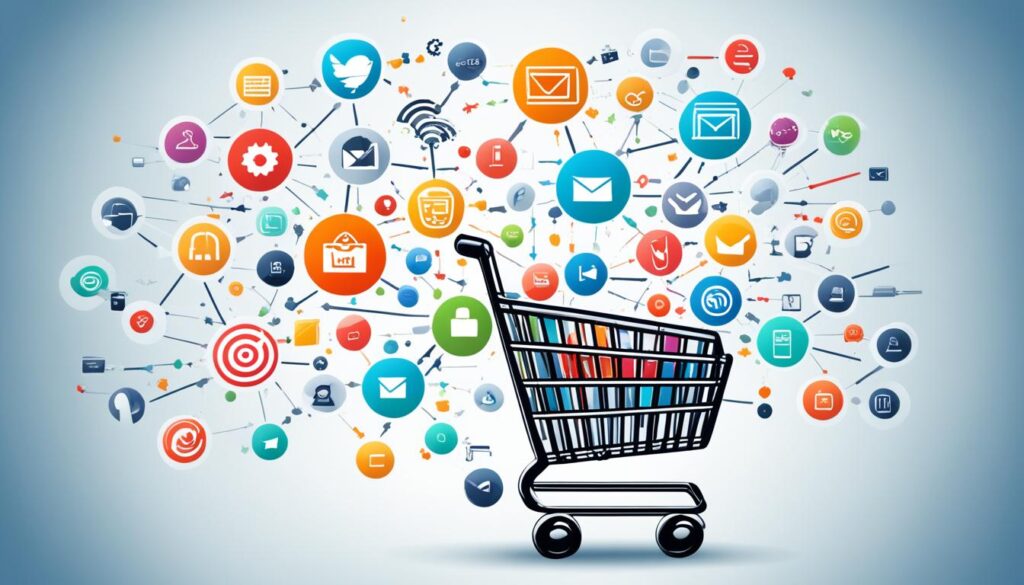Are you struggling to maximize your online sales and boost the visibility of your ecommerce brand? With the rapidly evolving digital landscape, it’s crucial to stay up-to-date on effective marketing strategies specifically tailored for ecommerce. From optimizing your website for search engines to leveraging the power of influencers, there are numerous tactics that can help you achieve long-term growth and success.
In this article, we will explore 21 actionable ecommerce marketing strategies that can take your online retailing to the next level. Whether you’re looking to increase online traffic, improve conversions, or enhance brand awareness, these tips and tactics will provide you with the insights and inspiration you need to thrive in the competitive ecommerce industry.
Key Takeaways:
- Invest in SEO to boost your website’s visibility and organic traffic.
- Run influencer marketing campaigns to reach new audiences and build brand awareness.
- Sell your products on online marketplaces to expand your reach and increase sales.
- Create a TikTok marketing strategy to tap into its growing user base and drive engagement.
- Utilize PPC campaigns to target and convert your audience effectively.
Invest in SEO
Ecommerce SEO is a vital component for driving organic traffic to your website. By implementing effective search engine optimization strategies, you can enhance your online visibility and attract more potential customers. Here are some key areas to focus on:
Keyword Research
Perform thorough keyword research to identify relevant terms and phrases that your target audience is searching for. Incorporate these keywords strategically into your website content, including product pages, URLs, meta descriptions, and headings.
Website Structure
Optimize your website structure to enhance user experience and search engine crawling. Ensure that your site is easy to navigate, with clear categories and intuitive menus. This will make it easier for both users and search engines to find and understand your content.
Backlink Building
Build high-quality backlinks from reputable websites to improve your website’s authority and credibility. Seek opportunities for guest blogging, collaborate with industry influencers, and engage in content marketing campaigns to attract authoritative links.
Optimized Product Pages
Optimize your product pages with relevant keywords, compelling descriptions, and high-quality images. Ensure that your product information is well-structured and easy to read, providing customers with all the necessary details to make informed purchase decisions.
Investing in ecommerce SEO can lead to significant improvements in your search engine rankings, driving more organic traffic to your website. This can ultimately result in higher click-through rates and increased sales for your ecommerce store.

| Benefits of Ecommerce SEO | Growth Potential |
|---|---|
| Increase organic traffic | Drive more qualified leads |
| Improve search engine rankings | Increase visibility and brand exposure |
| Enhance user experience | Boost conversions and sales |
| Build brand credibility | Establish long-term online presence |
Run an Influencer Marketing Campaign
Influencer marketing has emerged as a highly effective strategy for ecommerce brands to expand their reach, create brand awareness, and drive sales. By partnering with social media influencers who resonate with your target audience, you can leverage their large following and credibility to promote your products or services. Influencers are known for creating engaging content that showcases your brand and generates user-generated content, resulting in increased brand visibility and customer trust. Ultimately, this leads to higher conversions and improved brand recognition.
“Influencer marketing has become a powerful tool for ecommerce brands to reach new audiences, build brand awareness, and drive sales.”
To implement a successful influencer marketing campaign, it is crucial to align with influencers whose values and audience align with your brand. By collaborating with influencers who have a genuine connection with their followers, you can deliver a more authentic and relatable message. This targeted approach ensures that your brand resonates with the influencer’s audience, maximizing the impact of your campaign.
“By partnering with social media influencers who align with your target audience, you can leverage their following and credibility to promote your products or services.”
Influencer collaborations can take various forms, such as sponsored social media posts, product placements, giveaways, and even brand ambassadorships. The key is to foster a mutually beneficial relationship that allows influencers to create content that aligns with their audience’s interests while promoting your brand. By doing so, you can tap into the influencer’s loyal following and reach new potential customers who may have a genuine interest in your products or services.

Benefits of Influencer Marketing
- Increase Brand Awareness: Influencers have a dedicated and engaged audience, allowing you to expose your brand to a wider demographic and build brand recognition.
- Product Promotion: Influencers can effectively showcase your products, highlighting their features and benefits, and persuading their followers to make a purchase.
- Audience Targeting: Partnering with influencers who cater to your target market ensures that your brand message reaches the right audience, increasing the likelihood of conversions.
- Collaborations: Collaborating with influencers can lead to long-term partnerships, allowing you to establish a consistent presence and build a lasting relationship with their audience.
- User-Generated Content: Influencer campaigns generate a wealth of user-generated content that can be shared across social media platforms, further amplifying your brand message.
Implementing a well-planned influencer marketing campaign can significantly boost your ecommerce sales and help you achieve your marketing goals. By strategically selecting influencers, fostering authentic collaborations, and leveraging their influence, you can effectively expand your brand’s reach and drive meaningful engagement with your target audience.
Sell on Marketplaces
In today’s competitive ecommerce landscape, selling your products on online marketplaces is a strategic move that can significantly boost your brand’s visibility and drive sales. Marketplaces such as Amazon and eBay offer an unparalleled opportunity to reach a vast global audience and capitalize on their established infrastructure and customer base.
By listing your products on these popular platforms, you can tap into the immense potential of global ecommerce sales and expand your brand’s reach beyond your own branded store. Online marketplaces are trusted by customers worldwide, making them a reliable source for brand discovery and product purchases.
While considering selling on marketplaces, it’s essential to be aware of the selling fees and other associated costs. However, these fees are often outweighed by the benefits gained through increased brand visibility, customer reach, and additional sales opportunities.
Although selling on marketplaces complements your branded store, it’s crucial to maintain a consistent brand presence and messaging across all channels. This ensures a seamless customer experience and reinforces your brand’s identity in the minds of your audience.
Benefits of Selling on Marketplaces
- Increased brand visibility: Amazon and eBay have a massive customer base, which means your products have the potential to be discovered by a wider audience.
- Expanded customer reach: Online marketplaces enable you to access customers across the globe, expanding your target market beyond geographic boundaries.
- Trusted platforms for online shopping: Customers trust popular marketplaces like Amazon and eBay, which can boost their confidence in purchasing your products.
- Infrastructure and resources: Leveraging the existing infrastructure of marketplaces saves you time and resources required to build your own ecommerce platform from scratch.
- Additional sales opportunities: Selling on marketplaces provides you with an additional channel for generating sales and revenue alongside your branded store.
Selling on online marketplaces like Amazon and eBay can be a game-changer for ecommerce brands. They provide unparalleled access to a vast customer base and offer resources that can enhance your online presence and drive sales.

Online Marketplaces Comparison
| Marketplace | Benefits | Selling Fees | Global Reach |
|---|---|---|---|
| Amazon | Massive customer base, fulfillment options, robust advertising platform | Variable referral fees, fulfillment fees | Available in multiple countries |
| eBay | User-friendly interface, auction-style listings, diverse product categories | Listing fees, final value fees | Available in multiple countries |
| Alibaba | Wholesale marketplace, access to global suppliers and buyers | Membership fees, transaction fees | Strong focus on international trade |
When deciding which marketplace(s) to sell on, consider factors such as your target audience, product niche, and selling fees. Researching the specific requirements and benefits of each marketplace will help you make an informed decision that aligns with your ecommerce goals.
Create a TikTok Marketing Strategy
TikTok has become a popular social media platform with over a billion monthly active users. As an ecommerce brand, it offers a unique opportunity to engage with your audience and drive sales. By leveraging the platform’s algorithm and collaborating with influencers, you can create authentic and engaging content that increases brand awareness, establishes a loyal following, and drives traffic to your ecommerce store.
TikTok’s emphasis on short, viral videos makes it a perfect platform to showcase your products or services in a creative and entertaining way. By creating content that resonates with your target audience, you can capture their attention and encourage them to take action. Whether it’s through viral challenges, tutorials, or behind-the-scenes content, TikTok allows you to showcase your brand’s personality and connect with your audience on a deeper level.
One of the key advantages of TikTok marketing is its potential for virality. When a video goes viral on TikTok, it can reach millions of viewers within a short period of time. This can significantly increase your brand’s exposure and generate a surge of traffic to your ecommerce store.

In addition to creating your own content, collaborating with influencers can amplify your reach and credibility on TikTok. Partnering with influencers who have a strong presence on the platform can help you tap into their established audience and drive targeted traffic to your ecommerce store. Influencers can create sponsored content that showcases your products or services, providing social proof and increasing brand credibility.
TikTok also offers features like livestream shopping, which allows brands to directly sell products during live broadcasts. This interactive shopping experience enables real-time engagement with your audience and provides a seamless path to purchase, driving conversions and boosting sales.
Key Benefits of TikTok Marketing:
- Engage with a large and active user base
- Create authentic and entertaining content
- Showcase your brand’s personality
- Drive traffic and increase brand visibility
- Leverage the potential for virality
- Collaborate with influencers to reach new audiences
- Utilize features like livestream shopping for direct selling
By developing a comprehensive TikTok marketing strategy that includes content creation, influencer collaborations, and livestream shopping, you can tap into the platform’s growing user base and boost your ecommerce success. Start creating engaging TikTok content today and see the impact it can have on your brand’s visibility, audience engagement, and sales.
Run PPC Campaigns
Pay-per-click (PPC) advertising is a widely-used method for ecommerce brands to reach their target audience and drive conversions. Platforms like Google Ads and Facebook Ads allow us to create targeted ad campaigns that appear on search engines and social media platforms. By selecting the right keywords, optimizing ad copy, and utilizing retargeting strategies, we can maximize our ROI and drive relevant traffic to our ecommerce store.
PPC campaigns work especially well for ready-to-buy shoppers, increasing the likelihood of conversions. By strategically placing our ads in front of users who are actively searching for products or services, we can capture their attention at the right moment and guide them to make a purchase. These campaigns allow us to target specific demographics, interests, and locations, ensuring that our ads are seen by the most relevant audience.
One key benefit of PPC advertising is the ability to track and measure results through conversion tracking. We can set up conversion tracking codes on our website to monitor the actions users take after clicking on our ads, such as completing a purchase or filling out a lead form. This data allows us to assess the performance of our campaigns, make data-driven optimizations, and continuously improve our advertising strategy.
When creating PPC campaigns, it’s important to conduct thorough keyword research to identify the most relevant and high-converting keywords for our products or services. By incorporating these keywords into our ad copy, headlines, and landing pages, we can increase the visibility and click-through rates of our ads. Additionally, retargeting campaigns can be highly effective in re-engaging with users who have previously visited our website, reminding them of our products and encouraging them to return and complete a purchase.
Incorporating PPC campaigns into our overall marketing strategy allows us to effectively reach and convert our target audience. By leveraging the targeting capabilities of platforms like Google Ads and Facebook Ads, optimizing our ad campaigns, and tracking conversions, we can drive relevant traffic to our ecommerce store and maximize our online sales.
Upsell Your Products
Upselling and cross-selling are powerful techniques that can increase your sales and maximize the value of each customer. By offering slightly more premium products or additional items that complement the customer’s original purchase, you can enhance the overall customer experience and increase the average order value.
When implementing upsells, it is crucial to ensure that the products are closely related to the original purchase and aligned with the customer’s anticipated price range. By emphasizing the value and benefits of the upsell, you can effectively encourage customers to upgrade and increase their overall purchase value.
Benefits of Upselling:
- Maximize the value of each customer by increasing their purchase size
- Enhance the overall customer experience with premium products
- Encourage repeat purchases and customer loyalty
Tips for Successful Upselling:
- Understand your customer’s needs and preferences to offer relevant upsell options
- Highlight the added value and benefits of the upsell
- Ensure that the upsell offers a clear upgrade from the original purchase
- Recommend upsells that align with the customer’s anticipated price range
- Use persuasive language and visuals to showcase the upsell’s features and advantages
Implementing an effective upselling strategy can significantly boost your sales and enhance customer satisfaction. By offering premium products that meet customer needs and align with their price range, you can increase the value of each transaction and foster long-term customer loyalty.
| Upselling Benefits | Tips for Successful Upselling |
|---|---|
| Maximize customer value | Understand customer needs |
| Enhance customer experience | Highlight upsell value |
| Drive customer loyalty | Offer clear upgrades |

Integrate Instagram
Instagram is a powerful platform for ecommerce brands to boost their online presence and connect with their target audience. By leveraging the visual nature of the platform, you can showcase your products, increase brand exposure, and drive traffic to your ecommerce store.
One of the key advantages of using Instagram for marketing is the ability to create visually appealing content that captivates your audience. High-quality images and videos can effectively showcase your products in action, highlighting their key features and benefits. By curating a visually cohesive feed, you can establish a strong brand identity and attract potential customers.
Furthermore, Instagram’s shoppable posts feature enables you to tag products within your posts, allowing users to seamlessly explore and purchase your products without leaving the app. This convenient shopping experience can significantly increase your conversion rates and drive more sales.

Collaborating with influencers is another effective strategy to amplify your brand’s reach on Instagram. By partnering with influencers who align with your target audience, you can tap into their existing followers and generate authentic content that resonates with their community. Influencer collaborations can help you increase brand exposure, gain new followers, and drive traffic to your ecommerce store.
Instagram’s features like reels and stories provide additional opportunities for engagement and product promotion. Reels allow you to create short, attention-grabbing videos that can go viral and reach a wider audience. Stories give you a platform to share behind-the-scenes content, sneak peeks, and limited-time offers, fostering a sense of exclusivity and urgency among your audience.
Integrating Instagram into your marketing strategy is an effective way to enhance brand exposure, engage with your target audience, and drive traffic to your ecommerce store. By creating visually stunning content, utilizing shoppable posts, leveraging influencer collaborations, and taking advantage of Instagram’s unique features, you can increase your brand’s visibility and ultimately boost your online sales.
Reduce Abandoned Carts
Abandoned carts are a common challenge for ecommerce businesses. However, with the right strategies, you can recover lost sales and increase your conversion rates.
Implement email campaigns and retargeting ads to remind customers of their abandoned carts and incentivize them to complete their purchase. By sending personalized emails with enticing offers and highlighting the benefits of their chosen products, you can reignite their interest and encourage them to take action.

Create a sense of urgency
Utilize urgency techniques, such as limited-time offers or exclusive discounts, to create a sense of urgency and encourage immediate action. By adding countdown timers or showcasing low stock availability, you can create a fear of missing out (FOMO) that prompts customers to complete their purchase before it’s too late.
Optimize the checkout process
Ensure a seamless checkout process that is user-friendly and intuitive. Simplify the form fields, offer guest checkout options, and display progress indicators to reduce friction and streamline the purchase journey. The easier and faster it is for customers to complete their purchase, the less likely they are to abandon their carts.
Reduce abandoned carts, recover potential sales, and improve overall conversion rates by implementing effective strategies such as email campaigns, retargeting ads, creating a sense of urgency, and optimizing the checkout process.
Capture More Email Subscribers
Building an email subscriber list is a valuable asset for ecommerce brands. Email marketing allows us to directly reach our audience, promote our products or services, and nurture customer relationships. To maximize the effectiveness of our email marketing campaigns, we need to implement strategies to capture more email subscribers.
Offer Opt-In Incentives
One effective way to encourage visitors to subscribe to our email list is by offering opt-in incentives. These can be exclusive discounts, freebies, or valuable content that our target audience would find interesting and valuable. By providing an incentive for signing up, we increase the likelihood that visitors will willingly share their email addresses with us.
Optimize Newsletter Sign-Up Forms
The design and placement of our newsletter sign-up forms play a crucial role in capturing email subscribers. We should ensure that our sign-up forms are strategically placed on our website, such as in the header, footer, or pop-ups, making them easily noticeable and accessible. Additionally, we should keep the form fields simple and only ask for necessary information to reduce friction and increase conversion rates.
Utilize Pop-Ups and Landing Pages
Pop-ups and landing pages can be effective tools for capturing email subscribers. Pop-ups can be strategically triggered based on user behavior, such as exit intent or time on page, to offer incentives and encourage newsletter sign-ups. Landing pages can be dedicated to capturing email subscribers, providing valuable content or exclusive offers in exchange for email addresses.
Provide Valuable Content to Subscribers
To maintain a healthy and engaged email subscriber list, it’s crucial to consistently provide valuable content to our subscribers. This can include exclusive discounts, product updates, educational resources, or personalized recommendations. By delivering valuable content, we build trust and keep our subscribers engaged, increasing the likelihood of repeat business and referrals.
| Benefits of Capturing More Email Subscribers | Actions |
|---|---|
| Increased Reach: Growing our email list allows us to reach a larger audience with our marketing messages and promotions. | |
| Repeat Purchases: Email marketing is a powerful tool for driving repeat purchases from existing customers by nurturing relationships and providing personalized recommendations. | |
| Higher ROI: Compared to other marketing channels, email marketing often offers a higher return on investment due to its low cost and high conversion rates. |
In conclusion, implementing effective strategies to capture more email subscribers is essential for the growth and success of our ecommerce brand. By offering opt-in incentives, optimizing sign-up forms, utilizing pop-ups and landing pages, and providing valuable content, we can grow our email list, expand our reach, build customer loyalty, and drive higher ROI from our email marketing campaigns.
Improve Your Email Campaigns
Once you have a solid email subscriber list, it is important to optimize your email campaigns for maximum impact. Personalized emails, segmentation, automation, A/B testing, email analytics, and customer engagement are key factors in achieving success in your email marketing efforts.
Personalized Emails
Create a more personalized and tailored experience by addressing each subscriber by their name and using dynamic content that suits their preferences and past interactions. Personalization shows that you value your customers and their individual needs, leading to higher engagement and conversions.
Segmentation
Segment your email list based on specific criteria, such as demographics, purchasing behavior, or engagement level. By sending targeted content to different segments, you can deliver more relevant messages that resonate with each group, resulting in higher open and click-through rates.
Automation
Automate your email campaigns to ensure timely, relevant, and consistent communication with your subscribers. Set up automated workflows based on customer actions, such as welcome emails, abandoned cart reminders, or post-purchase follow-ups. Automation saves time and allows you to nurture relationships with your customers at various stages of their journey.
“Automation allows us to engage with customers at the right moment, helping us deliver timely and personalized messages that truly resonate with them.”
A/B Testing
Conduct A/B tests by creating different versions of your email campaigns to determine which elements, such as subject lines, call-to-action buttons, or visuals, resonate best with your audience. Analyze the results and make data-driven decisions to optimize your emails for higher engagement and conversion rates.
Email Analytics
Regularly analyze email analytics to gain insights into open rates, click-through rates, conversion rates, and other relevant metrics. Understand what content or strategies are driving the most engagement and adjust your email marketing strategy accordingly. Email analytics provide valuable data for continuous improvement.
Customer Engagement
Engage with your email subscribers by providing valuable content, exclusive offers, product updates, or relevant industry insights. Encourage them to interact with your emails by asking for feedback, running contests, or inviting them to participate in surveys. By fostering two-way communication, you can build stronger relationships and drive customer loyalty.
By continuously improving your email campaigns through personalized emails, segmentation, automation, A/B testing, email analytics, and customer engagement, you can effectively engage with your audience, drive conversions, and increase customer loyalty. Stay informed, adapt your strategies based on data, and provide valuable content to ensure your emails stand out in crowded inboxes.
Make It Easy for Customers to Get What They Want
Providing a seamless and user-friendly online shopping experience is crucial for ecommerce success. At our company, we prioritize user experience, ensuring that our website is designed with intuitive navigation and a clear layout that allows customers to easily find what they are looking for.
When customers visit our website, they should be able to navigate through different categories and product pages effortlessly. It is important to minimize the number of clicks and steps required for them to find their desired products. By streamlining the website navigation, we create a hassle-free experience that encourages customers to stay on our site and make a purchase.
Search functionality is another essential aspect of a customer-friendly website. We have implemented a robust search feature that allows customers to enter specific keywords or product names and quickly find relevant results. Our search function also supports autocomplete and suggestions, helping users refine their search and discover products they might have missed.
To further enhance the customer’s shopping experience, we have integrated product filters, making it easier for them to narrow down their options. By categorizing products based on various attributes such as price, size, color, and brand, customers can easily filter and sort the products to find exactly what they are looking for.
Clear Product Information is Key
When customers click on a product, they expect to find clear and detailed information that helps them make an informed purchasing decision. Our product pages provide comprehensive information including descriptions, specifications, pricing, and high-quality images. We believe that transparency is vital in gaining customer trust and confidence in our products.
By offering clear and accurate product information, we reduce the likelihood of customers experiencing buyer’s remorse or making returns due to misunderstandings. We want our customers to have a full understanding of our offerings, ensuring a seamless buying experience from start to finish.
“The easier it is for customers to navigate and find what they want, the more likely they are to make a purchase.” – Our CEO
By prioritizing user experience, implementing intuitive design and search functionality, and providing clear product information, we make it easy for customers to get what they want. Our goal is to create a seamless online shopping experience that drives customer satisfaction, increases conversions, and ultimately contributes to the growth of our ecommerce business.
Conclusion
Implementing effective marketing strategies is essential for the success of any ecommerce brand. By utilizing a combination of ecommerce marketing strategies, online retailing tips, and digital marketing tactics, you can maximize your online sales, boost your e-commerce visibility, improve online conversions, increase online traffic, and achieve continuous e-commerce growth.
To start, investing in SEO is crucial for driving organic traffic to your website. By optimizing your product pages, conducting keyword research, and building backlinks, you can improve your search engine rankings and increase your online visibility.
In addition, running influencer marketing campaigns can help you reach new audiences and build brand awareness. Collaborating with social media influencers who resonate with your target audience can generate user-generated content and increase customer trust, ultimately driving sales for your ecommerce business.
Moreover, leveraging marketplaces such as Amazon and eBay can expand your brand’s reach, allowing you to tap into their massive customer base and increase brand discovery. Selling on well-established marketplaces can complement your own branded store, providing additional sales opportunities and visibility.
By incorporating strategies like TikTok marketing, PPC campaigns, upselling, integrating Instagram, reducing abandoned carts, capturing more email subscribers, improving email campaigns, optimizing the user experience, and rewarding loyal customers, you can create a comprehensive marketing approach that drives long-term growth and success in the competitive ecommerce landscape.
Remember, continuous evaluation and adaptation based on data and customer feedback are key to staying ahead. By staying abreast of the latest industry trends and conducting regular analysis of your marketing efforts, you can ensure that you are effectively reaching your target audience, driving conversions, and achieving your e-commerce goals.




